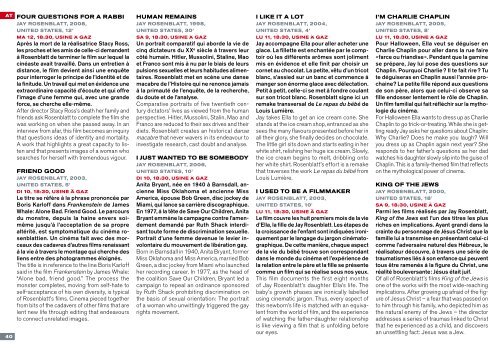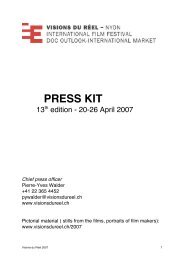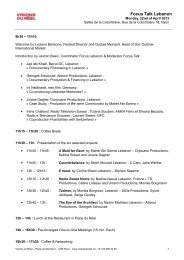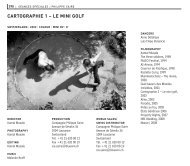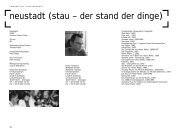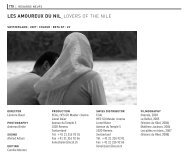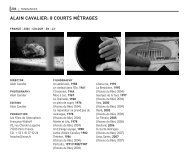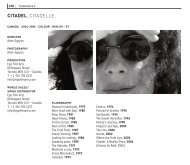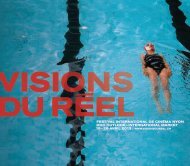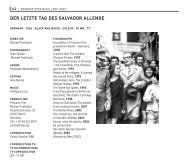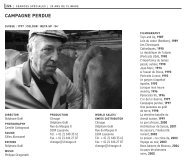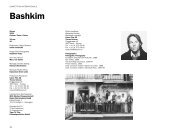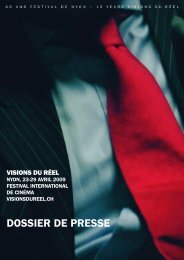2 - Visions du Réel
2 - Visions du Réel
2 - Visions du Réel
You also want an ePaper? Increase the reach of your titles
YUMPU automatically turns print PDFs into web optimized ePapers that Google loves.
AT FOUR QUESTIONS FOR A RABBIJAY ROSENBLATT, 2008,UNITED STATES, 12’HUMAN REMAINSJAY ROSENBLATT, 1998,UNITED STATES, 30’SA 9, 18:30, USINE À GAZUn portrait comparatif qui aborde la vie decinq dictateurs <strong>du</strong> XX e siècle à travers leurcôté humain. Hitler, Mussolini, Staline, Maoet Franco sont mis à nu par le biais de leurspulsions sexuelles et leurs habitudes alimentaires.Rosenblatt met en scène une dansemacabre de l’Histoire qui ne renonce jamaisà la primauté de l’enquête, de la recherche,<strong>du</strong> doute et de l’analyse.Comparative portraits of five twentieth centurydictators’ lives as viewed from the humanperspective. Hitler, Mussolini, Stalin, Mao andFranco are re<strong>du</strong>ced to their sex drives and theirdiets. Rosenblatt creates an historical dansemacabre that never wavers in its endeavour toinvestigate research, cast doubt and analyse.I LIKE IT A LOTJAY ROSENBLATT, 2004,UNITED STATES, 4’I’M CHARLIE CHAPLINJAY ROSENBLATT, 2005,UNITED STATES, 8'LU 11, 18:30, USINE À GAZPour Halloween, Ella veut se déguiser enCharlie Chaplin pour aller dans la rue faire« farce ou friandise ». Pendant que la gaminese prépare, Jay lui pose des questions surChaplin. Pourquoi Charlie ? Il te fait rire ? Tute déguiseras en Chaplin aussi l’année prochaine?La petite fille répond aux questionsde son père, alors que celui-ci observe safille endosser lentement le rôle de Chaplin.Un film familial qui fait réfléchir sur la mythologie<strong>du</strong> cinéma.For Halloween Ella wants to dress up as CharlieChaplin to go trick-or-treating. While she is gettingready Jay asks her questions about Chaplin:Why Charlie? Does he make you laugh? Willyou dress up as Chaplin again next year? Sheresponds to her father’s questions as her dadwatches his daughter slowly slip into the guise ofChaplin. This is a family-themed film that reflectson the mythological power of cinema.40MA 12, 18:30, USINE À GAZAprès la mort de la réalisatrice Stacy Ross,les proches et les amis de celle-ci demandentà Rosenblatt de terminer le film sur lequel lacinéaste avait travaillé. Dans un entretien àdistance, le film devient ainsi une enquêtepour interroger le principe de l’identité et dela finitude. Un travail qui met en évidence uneextraordinaire capacité d’écoute et qui offrel’image d’une femme qui, avec une grandeforce, se cherche elle-même.After director Stacy Ross’s death her family andfriends ask Rosenblatt to complete the film shewas working on when she passed away. In aninterview from afar, this film becomes an inquirythat questions ideas of identity and mortality.A work that highlights a great capacity to listenand that presents images of a woman whosearches for herself with tremendous vigour.FRIEND GOODJAY ROSENBLATT, 2003,UNITED STATES, 5’DI 10, 18:30, USINE À GAZLe titre se réfère à la phrase prononcée parBoris Karloff dans Frankenstein de JamesWhale: Alone Bad. Friend Good. Le parcours<strong>du</strong> monstre, depuis la haine envers soimêmejusqu’à l’acceptation de sa proprealtérité, est symptomatique <strong>du</strong> cinéma rosenblattien.Un cinéma fait avec des morceauxdes cadavres d’autres films renaissantà la vie à travers le montage qui cherche desliens entre des photogrammes éloignés.The title is in reference to the line Boris Karloffsaid in the film Frankenstein by James Whale:“Alone bad, friend good.” The process themonster completes, moving from self-hate toself-acceptance of his own diversity, is typicalof Rosenblatt’s films. Cinema pieced togetherfrom bits of the cadavers of other films that arelent new life through editing that endeavoursto connect unrelated images.I JUST WANTED TO BE SOMEBODYJAY ROSENBLATT, 2006,UNITED STATES, 10'DI 10, 18:30, USINE À GAZAnita Bryant, née en 1940 à Barnsdall, ancienneMiss Oklahoma et ancienne MissAmerica, épouse Bob Green, disc jockey deMiami, qui lance sa carrière discographique.En 1977, à la tête de Save Our Children, AnitaBryant emmène la campagne contre l’amendementdemandé par Ruth Shack interdisanttoute forme de discrimination sexuelle.Portrait d’une femme devenue le levier involontaire<strong>du</strong> mouvement de libération gay.Born in Barnsdall in 1940, Anita Bryant, formerMiss Oklahoma and Miss America, married BobGreen, a disc jockey from Miami who launchedher recording career. In 1977, as the head ofthe coalition Save Our Children, Bryant led acampaign to repeal an ordinance sponsoredby Ruth Shack prohibiting discrimination onthe basis of sexual orientation: The portraitof a woman who unwittingly triggered the gayrights movement.LU 11, 18:30, USINE À GAZJay accompagne Ella pour aller acheter uneglace. La fillette est enchantée par le comptoiroù les différents arômes sont jolimentmis en évidence et elle finit par choisir uncornet au chocolat. La petite, vêtu d’un tricotblanc, s’assied sur un banc et commence àmanger son énorme glace avec délectation.Petit à petit, celle-ci se met à fondre coulantsur son tricot blanc. Rosenblatt signe ici unremake transversal de Le repas <strong>du</strong> bébé deLouis Lumière.Jay takes Ella to get an ice cream cone. Shestands at the ice cream shop, entranced as shesees the many flavours presented before her inall their glory, she finally decides on chocolate.The little girl sits down and starts eating in herwhite shirt, relishing her huge ice cream. Slowly,the ice cream begins to melt, dribbling ontoher white shirt. Rosenblatt’s effort is a remakethat traverses the work Le repas <strong>du</strong> bébé fromLouis Lumière.I USED TO BE A FILMMAKERJAY ROSENBLATT, 2003,UNITED STATES, 10'LU 11, 18:30, USINE À GAZLe film couvre les huit premiers mois de la vied’Ella, la fille de Jay Rosenblatt. Les étapes dela croissance de l’enfant sont indiquées ironiquementpar le langage <strong>du</strong> jargon cinématographique.De cette manière, chaque aspectde la vie <strong>du</strong> bébé trouve son correspondantdans le monde <strong>du</strong> cinéma et l’expérience dela relation entre le père et la fille se présentecomme un film qui se réalise sous nos yeux.This film documents the first eight monthsof Jay Rosenblatt’s daughter Ella’s life. Thebaby’s growth phases are ironically labelle<strong>du</strong>sing cinematic jargon. Thus, every aspect ofthis newborn’s life is matched with an equivalentfrom the world of film, and the experienceof watching the father-daughter relationshipis like viewing a film that is unfolding beforeour eyes.KING OF THE JEWSJAY ROSENBLATT, 2000,UNITED STATES, 18'SA 9, 18:30, USINE À GAZParmi les films réalisés par Jay Rosenblatt,King of the Jews est l’un des titres les plusriches en implications. Ayant grandi dans lacrainte <strong>du</strong> personnage de Jésus Christ que lafamille lui a transmise en présentant celui-cicomme l’adversaire naturel des Hébreux, leréalisateur découvre, à travers une série detraumatismes liés à son enfance qui peuventtous être ramenés à la figure <strong>du</strong> Christ, uneréalité bouleversante: Jésus était juif.Of all of Rosenblatt’s films King of the Jews isone of the works with the most wide-reachingimplications. After growing up afraid of the figureof Jesus Christ – a fear that was passed onto him through his family, who depicted him asthe natural enemy of the Jews – the directoraddresses a series of traumas linked to Christthat he experienced as a child, and discoversan unsettling fact: Jesus was a Jew.


